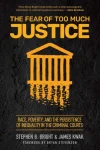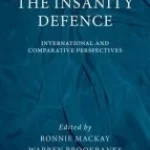The Fear of Too Much Justice: How Race and Poverty Undermine Fairness in the Criminal Courts
 Authors: Stephen Bright & James Kwak
Authors: Stephen Bright & James Kwak
Publisher: The New Press, 2023. 368 pages.
Reviewer: Marc Bookman | June 2023
When reading a book about criminal injustice, there is always a concern that the writers have done a little cherry-picking. Sure, there is the occasional sleeping lawyer or unscrupulous prosecutor or bloodthirsty judge, the thinking goes, but those examples are outliers in a system that’s doing the very best it can under challenging circumstances. Such thoughts are soon dissipated when one begins The Fear Of Too Much Justice, however, as the book is so thoroughly researched that the reader may wonder how we have tolerated this system as long as we have. Written by iconic civil rights attorney Steve Bright and his former student from Yale Law School, James Kwak, the volume is a virtual roadmap of the mistakes we continue to make, and the remedies that are obvious once you see them on the page.
The first chapter, entitled The Myth Of The Adversary System, is an overview of the entire work. In what they label “a caricature of zealous representation,” the authors describe an all-too-common scene that might seem from another age:
In some places, people in handcuffs and leg irons are herded into the courtroom and placed in the jury box and the front rows of the gallery. Often so many of them are people of color that it looks as if a slave ship has docked outside the courthouse. They wear jumpsuits—often orange, but sometimes with old-fashioned black-and-white stripes. One or more court-appointed attorneys walks down the line, often meeting their “clients” for the first time. In these brief, non-confidential conversations, the lawyers explain that the prosecutor will drop some of the charges or recommend a lighter sentence if the client pleads guilty, but will insist upon a severe sentence if the client exercises his right to trial….In some places, this system is called “McJustice.” In others, it is known as “meet ‘em and plead ‘em. As one public defender said after standing beside seventeen people as they entered guilty pleas: “I met ‘em, pled ‘em, and closed ‘em – all in the same day.”
The story of Hills McGee follows later in the same chapter. A man on a meager Veterans Administration monthly income, McGee was arrested for public drunkenness and obstruction, pled guilty without a lawyer (he was told it cost $50 to apply for a public defender, which he could not afford – no one told him the fee could be waived), and ended up with a fine of $200 and monthly costs to a private probation company. After one year, in which he’d managed to pay $552, McGee went back to jail for failure to pay off all his fines and costs. You get the idea – this simply is not the way a functioning criminal justice system is supposed to work.
One thread that runs through the entire book is the pernicious effect of race on almost all courtrooms in the country. At every turn – pretrial detention, weak and lacking systemic representation, prosecutorial overcharging, application of mandatory sentences – Black defendants suffer the inadequacies and excesses of a criminal justice system run amuck. Consider some of the statistics:
Prosecutors make greater use of habitual-offender sentencing enhancements with minority defendants than with whites. In 1995 in Georgia, 375 people were serving sentences of life imprisonment for a second drug trafficking conviction; 369 of them—more than 98 percent—were Black. Even in a state where Blacks are arrested and imprisoned for drug offenses at higher rates than whites, this figure seems impossible. What made it possible was a statute that purported to require a life sentence but effectively gave prosecutors discretion over whether or not to request that sentence. From 1990 to 1994, Georgia prosecutors chose to invoke the “mandatory” life sentence for 202 out of 1,107 African Americans who were eligible for it, but only one out of 167 eligible whites.
These race effects, as stark as they were, are hardly ancient history. As the authors point out in their chapter entitled An Excess Of Punishment, “The Washington Supreme Court unanimously held in 2018 that the death penalty was being imposed in an ‘arbitrary and racially biased manner’ and violated the state constitution. The Court based its decision on a statistical study showing that Blacks were between 3.5 and 4.6 times as likely to be sentenced to death as non-Blacks.”
Nor should the reader conclude that such race effects, while telling, are unintentional. In the chapter called The Whitewashed Jury, Bright and Kwak walk us through a detailed and compelling history of how prosecutors have managed to keep Black citizens out of the jury room. Bright in particular knows of what he writes, having prevailed in the United States Supreme Court three times arguing the intentionality of prosecutorial discrimination in jury selection. It goes without saying that there is no actual humor in a book dedicated to explicating the root causes of injustice, but the lengths prosecutors are willing to go to in order to whitewash a jury test the boundaries of absurdity. For instance, consider a partial list of “race-neutral” reasons the Texas District and County Attorney’s Association offer for striking a Black citizen: body language, poor facial expression, anger, expressionless, inattentive, or no religious preference. And if none of those reasons are sufficient, there is this reviewer’s personal favorite – either “didn’t speak” or “very vocal.”
The Fear Of Too Much Justice would be worthwhile reading if it simply was a catalogue of problems with the criminal justice system; but of course, it does much more. The authors take great pains to point out that these problems are not intransigent, but have solutions that have already been shown to work. Some, like the elimination of peremptory challenges in jury selection, are controversial even on the progressive side of the aisle. Others, like the federal First Step Act or “second look” laws passed in states like California and Washington and the District of Columbia, have provided much-needed hope for many over-incarcerated prisoners who could be safely released back to the community if only the law provided a mechanism in which to do so. Suggestions such as the elimination of cash bail for minor offenses and fines and fees to raise revenues have already been shown to work in some jurisdictions.
The real message from this book is a simple one – face the obvious problems head-on, and recognize that dealing with them honestly has greater benefits than the detriments that concern us:
There is a fear that embracing the principles of fairness—full disclosure of information, not relying on jailhouse snitches, competent counsel for the accused, grappling with issues of racial discrimination and unequal treatment—will risk the loss of convictions. But there is far more to be gained by having a system in which all of the participants are fully informed and decisions are made based on a thorough exploration of all of the facts of the crime and the circumstances of the person accused of committing it.
In short, what Bright and Kwak are saying is that the problems that have bedeviled our criminal justice system for more than a century are indeed fixable if we just have the will. Or as the great community organizer Saul Alinsky once said, “we’ll see it when we believe it.”
Marc Bookman is the Executive Director of the Atlantic Center for Capital Representation.


